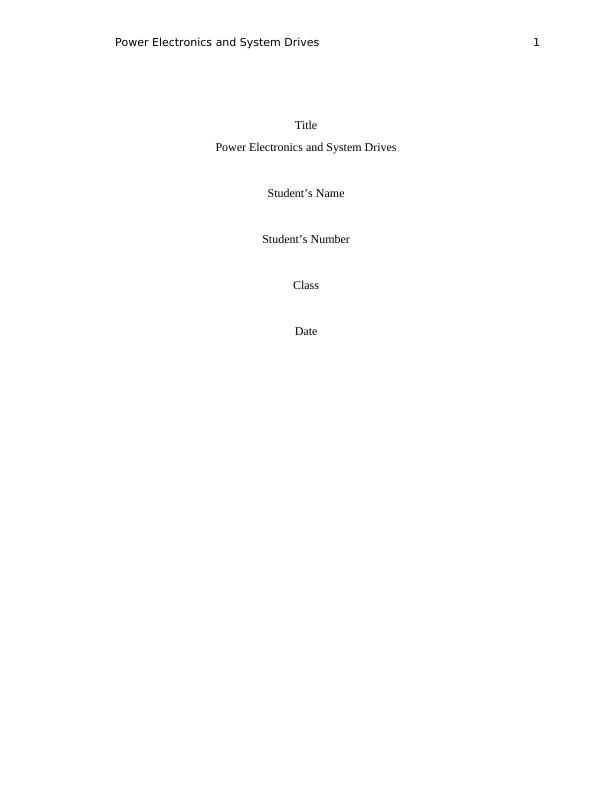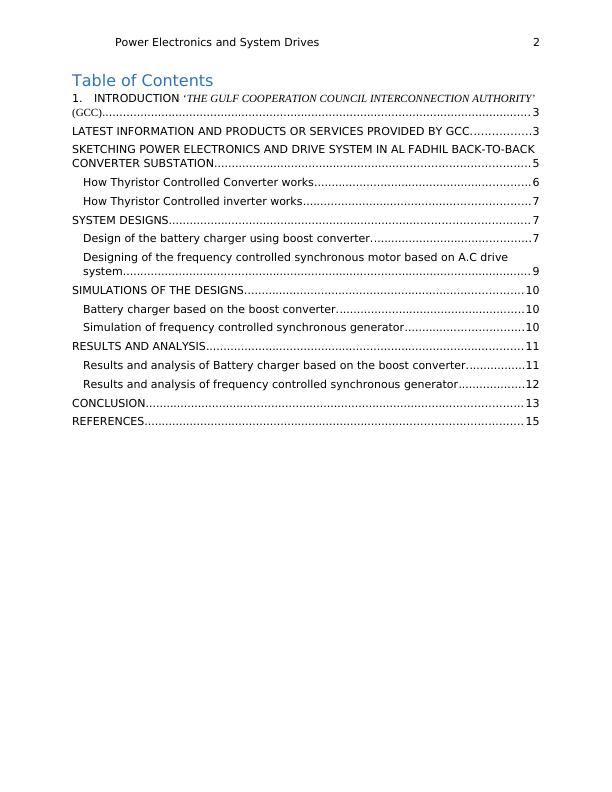Power Electronics and System Drives
Added on 2022-11-29
16 Pages2075 Words484 Views
Power Electronics and System Drives 1
Title
Power Electronics and System Drives
Student’s Name
Student’s Number
Class
Date
Title
Power Electronics and System Drives
Student’s Name
Student’s Number
Class
Date

Power Electronics and System Drives 2
Table of Contents
1. INTRODUCTION ‘THE GULF COOPERATION COUNCIL INTERCONNECTION AUTHORITY’
(GCC)........................................................................................................................... 3
LATEST INFORMATION AND PRODUCTS OR SERVICES PROVIDED BY GCC.................3
SKETCHING POWER ELECTRONICS AND DRIVE SYSTEM IN AL FADHIL BACK-TO-BACK
CONVERTER SUBSTATION.......................................................................................... 5
How Thyristor Controlled Converter works..............................................................6
How Thyristor Controlled inverter works.................................................................7
SYSTEM DESIGNS....................................................................................................... 7
Design of the battery charger using boost converter..............................................7
Designing of the frequency controlled synchronous motor based on A.C drive
system..................................................................................................................... 9
SIMULATIONS OF THE DESIGNS................................................................................10
Battery charger based on the boost converter......................................................10
Simulation of frequency controlled synchronous generator..................................10
RESULTS AND ANALYSIS........................................................................................... 11
Results and analysis of Battery charger based on the boost converter.................11
Results and analysis of frequency controlled synchronous generator...................12
CONCLUSION............................................................................................................ 13
REFERENCES............................................................................................................ 15
Table of Contents
1. INTRODUCTION ‘THE GULF COOPERATION COUNCIL INTERCONNECTION AUTHORITY’
(GCC)........................................................................................................................... 3
LATEST INFORMATION AND PRODUCTS OR SERVICES PROVIDED BY GCC.................3
SKETCHING POWER ELECTRONICS AND DRIVE SYSTEM IN AL FADHIL BACK-TO-BACK
CONVERTER SUBSTATION.......................................................................................... 5
How Thyristor Controlled Converter works..............................................................6
How Thyristor Controlled inverter works.................................................................7
SYSTEM DESIGNS....................................................................................................... 7
Design of the battery charger using boost converter..............................................7
Designing of the frequency controlled synchronous motor based on A.C drive
system..................................................................................................................... 9
SIMULATIONS OF THE DESIGNS................................................................................10
Battery charger based on the boost converter......................................................10
Simulation of frequency controlled synchronous generator..................................10
RESULTS AND ANALYSIS........................................................................................... 11
Results and analysis of Battery charger based on the boost converter.................11
Results and analysis of frequency controlled synchronous generator...................12
CONCLUSION............................................................................................................ 13
REFERENCES............................................................................................................ 15

Power Electronics and System Drives 3
1. INTRODUCTION ‘THE GULF COOPERATION COUNCIL INTERCONNECTION
AUTHORITY’ (GCC)
High Voltage Direct Current (HVDC) transmission is the electrical transmission system that
evacuated power using direct current. HVDC transmission system can also transfer power
between systems with unsynchronized A.C frequency. HVDC transmission system comprises of
the following fundamental components highlighted below;
i. Converter substation and converter units
ii. Converter valves and converter transformers
iii. A.C, D.C, and high frequency filters.
iv. Reactors and reactive power source
Conversion and inversion of power between A.C and D.C is coordinated by cascading converter
transformers and converter valves (Anshika R, 2019). In this report, the application of power
electronics and drive systems in the converter substation will be dealt with. There are different
types of HVDC converter substation namely; Back-to-back substation, two terminal HVDC
substation, and multi-terminal DC substation (Circuit Globe, 2019).
The case study is based on back-to-back converter substation of ‘The Gulf Cooperation Council
Interconnection Authority’ (GCC). This substation connected to 400kV grid was commissioned
in 2009, connecting Bahrain, Kuwait, Qatar, Oman, United Arab Emirates and Saudi Arabia. The
project has tremendously benefited GCC countries in terms of curbing power emergency. In the
first phase of construction, existing power grid system operating at 60 Hz, 380kV was merged to
50Hz, 400-kV interconnection system of Bahrain, Saudi Arabia, Qatar and Kuwait by installing
1200-WM back-to-back substation (Ahmed Ali Ebrahim, 2012).
HVDC back-to-back substation transmits A.C power between buses in the same location without
installing HVDC transmission lines. The 1200-MW back-to-back substation provided an
asynchronous connection between independently controlled 60Hz, 380 kV power grid and 50Hz,
400-kV power grid without transferring frequency disturbances.
LATEST INFORMATION AND PRODUCTS OR SERVICES PROVIDED BY GCC.
Project planning and actualization was driven by many factors including growth in energy
demand. High cost of oil and gases led to massive decline in consumption of oil and natural
gases. As a result, the phenomena spurred increase in demand of electricity, which then was
cheaper source of electric power. Also economic dynamics influenced by foreign investors and
industrialization of GCC countries triggered electric power interconnection deals among them. It
is recorded that the recent growth in energy demand for those GCC countries rose from 7% to
14%. The table below shows energy demand growth for the six countries as from the year 2003
and prospective trend until 2028.
1. INTRODUCTION ‘THE GULF COOPERATION COUNCIL INTERCONNECTION
AUTHORITY’ (GCC)
High Voltage Direct Current (HVDC) transmission is the electrical transmission system that
evacuated power using direct current. HVDC transmission system can also transfer power
between systems with unsynchronized A.C frequency. HVDC transmission system comprises of
the following fundamental components highlighted below;
i. Converter substation and converter units
ii. Converter valves and converter transformers
iii. A.C, D.C, and high frequency filters.
iv. Reactors and reactive power source
Conversion and inversion of power between A.C and D.C is coordinated by cascading converter
transformers and converter valves (Anshika R, 2019). In this report, the application of power
electronics and drive systems in the converter substation will be dealt with. There are different
types of HVDC converter substation namely; Back-to-back substation, two terminal HVDC
substation, and multi-terminal DC substation (Circuit Globe, 2019).
The case study is based on back-to-back converter substation of ‘The Gulf Cooperation Council
Interconnection Authority’ (GCC). This substation connected to 400kV grid was commissioned
in 2009, connecting Bahrain, Kuwait, Qatar, Oman, United Arab Emirates and Saudi Arabia. The
project has tremendously benefited GCC countries in terms of curbing power emergency. In the
first phase of construction, existing power grid system operating at 60 Hz, 380kV was merged to
50Hz, 400-kV interconnection system of Bahrain, Saudi Arabia, Qatar and Kuwait by installing
1200-WM back-to-back substation (Ahmed Ali Ebrahim, 2012).
HVDC back-to-back substation transmits A.C power between buses in the same location without
installing HVDC transmission lines. The 1200-MW back-to-back substation provided an
asynchronous connection between independently controlled 60Hz, 380 kV power grid and 50Hz,
400-kV power grid without transferring frequency disturbances.
LATEST INFORMATION AND PRODUCTS OR SERVICES PROVIDED BY GCC.
Project planning and actualization was driven by many factors including growth in energy
demand. High cost of oil and gases led to massive decline in consumption of oil and natural
gases. As a result, the phenomena spurred increase in demand of electricity, which then was
cheaper source of electric power. Also economic dynamics influenced by foreign investors and
industrialization of GCC countries triggered electric power interconnection deals among them. It
is recorded that the recent growth in energy demand for those GCC countries rose from 7% to
14%. The table below shows energy demand growth for the six countries as from the year 2003
and prospective trend until 2028.

Power Electronics and System Drives 4
Table 1: GCC countries demand Growth in MW (Adnan Al-Mohaisen, 2019).
The trend has it that energy demand has been quantitatively increasing annually to an extend of
surpassing potential electricity production of some of the countries. The GCC countries had
therefore to collaborate in the aforementioned mega-project to quench energy deficit. However,
as shown in the table below, of the six countries, Saudi Arabia is operating its power at a
frequency of 60Hz as opposed to 50 Hz. For such un-avoided reasons, a double circuit 400Kv,
50Hz line from Al Zour, Kuwait is interconnected to Saudi Arabia 380-Kv, 60Hz line via a back-
to-back converter at Al Fadhili substation in Saudi Arabia (Adnan Al-Mohaisen, 2019).
Fig 1: HV converter transformers 400 kV /380 MVA at Al Fadhili (Carl Barker, 2019)
Table 1: GCC countries demand Growth in MW (Adnan Al-Mohaisen, 2019).
The trend has it that energy demand has been quantitatively increasing annually to an extend of
surpassing potential electricity production of some of the countries. The GCC countries had
therefore to collaborate in the aforementioned mega-project to quench energy deficit. However,
as shown in the table below, of the six countries, Saudi Arabia is operating its power at a
frequency of 60Hz as opposed to 50 Hz. For such un-avoided reasons, a double circuit 400Kv,
50Hz line from Al Zour, Kuwait is interconnected to Saudi Arabia 380-Kv, 60Hz line via a back-
to-back converter at Al Fadhili substation in Saudi Arabia (Adnan Al-Mohaisen, 2019).
Fig 1: HV converter transformers 400 kV /380 MVA at Al Fadhili (Carl Barker, 2019)

End of preview
Want to access all the pages? Upload your documents or become a member.
Related Documents
Facts Devices and HVDC - An Overviewlg...
|3
|699
|214
The Need for Inverters and Their Application Areaslg...
|5
|861
|39
